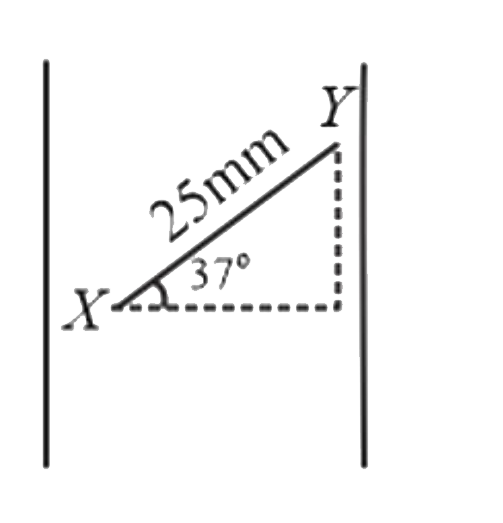A small oil drop of mass 10−6 kg is hanging in at rest between two plates separated by 1 mm having in at rest between two plates separated by 1 mm having a potential difference of 500 V. The charge on the drop is (g=10ms−2)
2×10−9C
2×10−11C
2×10−6C
2×10−9C
The correct Answer is:D
To solve the problem of finding the charge on the oil drop, we can follow these steps:
1. Identify the Forces Acting on the Oil Drop:
The oil drop is in equilibrium, meaning the gravitational force acting downwards is balanced by the electric force acting upwards.
Fgravity=mg
Felectric=QE
2. Set Up the Equation for Equilibrium:
Since the drop is at rest, we can equate the two forces:
mg=QE
3. Calculate the Electric Field (E):
The electric field (E) between two parallel plates is given by the formula:
E=Vd
where V is the potential difference and d is the separation between the plates. Given V=500V and d=1mm=1×10−3m:
E=500V1×10−3m=500000V/m
4. Substitute E into the Equilibrium Equation:
Rearranging the equilibrium equation gives:
Q=mgE
5. Substitute Known Values:
We know:
- Mass m=10−6kg
- Gravitational acceleration g=10m/s2
- Electric field E=500000V/m
Now substituting these values into the equation:
Q=(10−6kg)(10m/s2)500000V/m
6. Calculate the Charge (Q):
Q=10−5kg m/s2500000V/m=10−55×105=2×10−11C
Final Answer
The charge on the oil drop is Q=2×10−11C.
---
The oil drop is in equilibrium, meaning the gravitational force acting downwards is balanced by the electric force acting upwards.
Felectric=QE
Since the drop is at rest, we can equate the two forces:
mg=QE
The electric field (E) between two parallel plates is given by the formula:
E=Vd
where V is the potential difference and d is the separation between the plates. Given V=500V and d=1mm=1×10−3m:
E=500V1×10−3m=500000V/m
Rearranging the equilibrium equation gives:
Q=mgE
We know:
- Mass m=10−6kg
- Gravitational acceleration g=10m/s2
- Electric field E=500000V/m
Q=(10−6kg)(10m/s2)500000V/m
Q=10−5kg m/s2500000V/m=10−55×105=2×10−11C
The charge on the oil drop is Q=2×10−11C.
Topper's Solved these Questions
- BOOK - DC PANDEYCHAPTER - ELECTROSTATIC POTENTIAL AND CAPACITORSEXERCISE - (B) Chapter exercises20videos
ELECTROSTATIC POTENTIAL AND CAPACITORS
- BOOK - DC PANDEYCHAPTER - ELECTROMAGNETIC WAVESEXERCISE - Sec C22videos
ELECTROMAGNETIC WAVES
- BOOK - DC PANDEYCHAPTER - ELECTROSTATICSEXERCISE - Medical entrances gallery37videos
ELECTROSTATICS
Similar Questions
In Millikan's oil drop experiment, a charged oil drop of mass 3.2×10−14kg is held stationary between two parallel plates 6mm apart by applying a potential difference of 1200V between them. How many excess electrons does the oil drop carry? Take g=10ms−2
View SolutionA liquid drops hangs in equillibrium between two copper plates separated by a distacnce of 2cm and maintained at a potential difference of 600 volts. Calculate the charge on the drops if the radius of the drop is 0.1mm and density of the liquid is 800kg/m3
View Solution
Knowledge Check
- Question 1 - Select One
An electron enters between two horizontal plates separated by 2mm and having a potential difference of 1000V. The force on electron is
A8×10−12NB8×10−14NC8×10−9ND8×1014N - Question 2 - Select One
Find the charge on parallel plate capacitor having circular plates of radius 8 cm and plate separation 1 mm. The potential difference is 100 V:
A1.78×10−5 CB2×10−9CC1.78×10−8CD4.3×104C - Question 3 - Select One
In Millikan oil drop experiment, a charged drop of mass 1.8×10−14kg is stationary between its plates. The distance between its plates is 0.90cm and potential difference is 2.0 kilo volts. The number of electrons on the drop is
A500B50C5D0
Two plane parallel conducting plates 1.5×10−2m apart are help horizontally one aove the other in air. The upper plate is maintained at positive potential of 1.5 kV while the other plate is earthed. Calculate the number of electorns which must be attached to a small oil drop of mass 4.9×10−15kg between the plates to maintain it at rest. If the potential of upper plate is suddenly changed to −1.5 kV, what is the initial acceleration of the charged drop ? Also obtain the terminal velocity of the drop if its radius is 5×10−6m and coefficient of viscosity of air is 1.8×10−5N−s/m2. Assuming that the density of air is negligible in comparison with that of oil.
View SolutionTwo large parallel conducting plates are separated by 40 mm. The potential difference between the plates is V. Potential difference between points X and Y as indicated in the figure will be
 View Solution
View SolutionThe p.d between two plates separated by a distance of 1mmis100V.The force on an electron placed in between the plates is
View SolutionA particle of mass 1.96×10−15 kg is kept in equilibrium between two horizontal metal plates having potential difference of 400 V separated apart by 0.02 m. then the charge on the particle is (e= electronic charge)
View SolutionIn Millikan's experiment, an oil drop having charge q gets stationary on applying a potential difference V in between two plates separated by a distance 'd'. The weight of the drop is
View Solution

